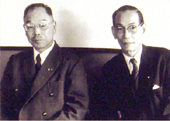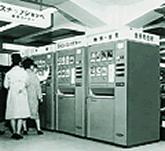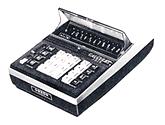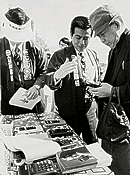2. Enhancing Lifestyles in Japan
Facing the Challenge of the Cybernation Revolution (1960-1970)
The decade from 1960 to 1970 saw the advancement of automation technology and the emergence of the new society described by Dr. Norbert Wiener in his "cybernetics" theory. These years provided our first real glimpse of the comfort and convenience made possible by automation.
COLUMN
Encounter with Automation and Cybernetics


left, with Mr. Tateisi
In 1952, OMRON founder Kazuma Tateisi encountered two new concepts: automation and cybernetics. He first heard the word "automation" during a meeting with Professor Yoichi Ueno, known as the "father of Japanese administrative science."
Tateisi's first encounter with cybernetics was when he heard about a book entitled "Cybernetics: Control and Communication in the Animal and the Machine" from Dr. Katsuzo Nishi, founder the Nishi System of Health Engineering.
Tateisi's encounter with these concepts marked a decisive milestone on OMRON's path to the highly promising market of automated control technology.
1963: The First Step Toward Cybernation
Development of an automatic ticket vending machine

In 1963, OMRON learned that an automatic vending machine and bill changer would be displayed in the US pavilion at the Tokyo International Trade Fair. This inspired us to develop and display an automatic vending machine and bill changer that could outperform products made in the U.S., which was the industrial leader at that time.
Following this, we developed the world's first multifunction meal ticket vending machine, which was able to issue three different types of meal ticket. The machine was put into operation at the Daimaru department store in Kyoto. These developments paved the way for the "Cybernation Revolution."
1964: Tackling Motorization Issues
Development of an automated traffic signal

In the 1960s, the growth of the Japanese economy brought an increase in traffic, creating a substantial need for traffic control solutions to prevent accidents and ease traffic congestion. In response to an order from the National Research Institute of Police Science, OMRON developed a vehicle detection and signal control system. In April 1964, a traffic-responsive electronic signal proved effective in field tests conducted at a major intersection in Kyoto. OMRON then developed an automated traffic signal, the first of kind in the world, which was put into operation at an intersection in Tokyo in June of the same year.
OMRON steadily upgraded its signal control technology to increase functions and broaden the control area, building the foundation of today's traffic control system.
1967: Developing an Unmanned Train Station System
Development of an automated ticket gate system
In the mid-1960s, expectations for labor-saving systems increased in every corner of society. In response, OMRON began work on a new type of railway station, and in 1964 embarked on the development of an automated ticket gate for commuters in collaboration with Kinki Nippon Railway.
OMRON later developed an automated ticket gate capable of handling both commuter passes and regular train tickets for Hankyu Railway's new Kitasenri station. The world's first fully automated (unmanned) train station system was completed and put it into use in 1967.

(Hankyu Railway, Kitasenri Station)
1971: The Beginning of a Cashless Age
Development of an automated cash dispenser

In 1965, OMRON developed an automated vending machine capable of accepting credit cards in cooperation with Automatic Canteen Co., then the largest vending machine manufacturer in the United States. Subsequently, OMRON went on to develop new card systems, installing an off-line automated cash dispenser, which used a magnetic card, at Sumitomo Bank in 1969. In 1971, we delivered the world's first on-line automated cash dispenser to the central branch of Mitsubishi Bank. These developments became the basis for today's magnetic card systems and marked the beginning of a "cashless age" in Japan.
1974: Popularizing Desktop Calculators
Development of 'OMRON-8'
OMRON entered the desktop calculator field in the late 1960s in response to the increasing popularity of calculators in Japan. In 1969, OMRON launched the world's smallest desktop calculator, the CALCULET 1200. The CALCULET's successor, the low-cost OMRON 800 (popularly known as OMRON-8), contributed to the widespread adoption of calculators. LSI and other technologies OMRON implemented in the production of calculators would later spur developments in advanced computation and control technologies.
-

The CALCULET 1200was the world'ssmallest desktopcalculator at the time ofits release -

Sidewalk sale of OMRON-8
1978: Using Electoronic Equipment to Manage Health
Development of digital thermometers and blood pressure monitors

In the mid-1970s, OMRON established a dedicated "health engineering" department to study methods of collecting biometric data, an essential aspect of health management. Our collaboration with medical associations and medical schools at major universities throughout Japan produced various hit products in the healthcare field such as a digital blood pressure monitor (introduced in 1978) and digital thermometer (introduced in 1983).
COLUMN
OMRON Taiyo Co., Ltd.: "Not charity, but a chance!"

In 1971, the founder of Japan Sun Industries, Dr. Yutaka Nakamura, and writer and social commentator Chieko Akiyama visited OMRON to ask for assistance in establishing a factory for people with severe physical disabilities. Dr. Nakamura believed that people with disabilities did not need sympathy, just an opportunity to work. This was expressed in Japan Sun Industries' motto, "Not charity, but a chance!" The following year, OMRON and Japan Sun Industries jointly established OMRON Taiyo Co., Ltd., in Beppu, Oita Prefecture. OMRON Taiyo's business expanded, prompting the establishment of a second factory in 1981, and another joint venture, OMRON Kyoto Taiyo Co., Ltd., in 1986.
